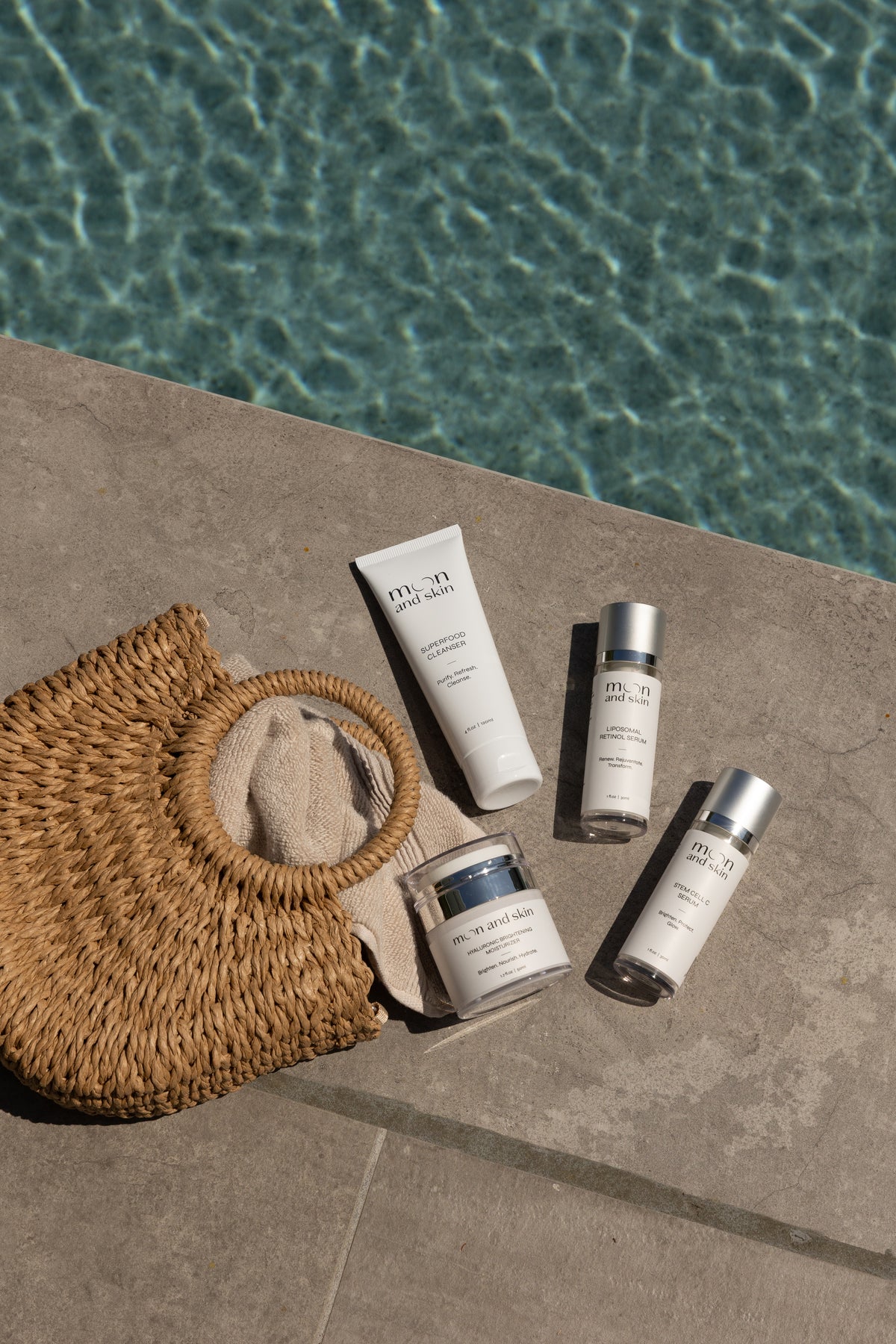Table of Contents
- Introduction
- What is Vitamin E?
- Benefits of Vitamin E for Skin Health
- Causes of Hyperpigmentation
- How Vitamin E Helps Reduce Hyperpigmentation
- Effectiveness of Vitamin E Cream for Hyperpigmentation
- How to Incorporate Vitamin E for Hyperpigmentation
- Potential Adverse Effects of Vitamin E Cream
- Wrapping Up
Introduction
Have you ever looked in the mirror and felt frustrated by those stubborn dark spots marring your complexion? You're not alone. Hyperpigmentation, characterized by patches of skin that become darker than the surrounding areas, is a common concern for many of us. Whether it's from sun exposure, hormonal changes, or post-inflammatory responses due to acne, these dark spots can be a source of self-consciousness.
At Moon and Skin, we understand the challenges of dealing with uneven skin tone. Our mission is to provide clean, thoughtful skincare that nurtures and celebrates your skin through all its phases, much like the changing moon. One ingredient that often emerges in conversations about skin health is Vitamin E. But the question remains: Is Vitamin E good for hyperpigmentation?
In this blog post, we will explore the benefits of Vitamin E for skin health, how it interacts with hyperpigmentation, and practical ways to incorporate it into your skincare routine. We aim to empower you with knowledge about how to enhance your skin’s appearance and overall health.
What is Vitamin E?
Vitamin E, also known as tocopherol, is a group of fat-soluble compounds with powerful antioxidant properties. This essential nutrient plays a crucial role in protecting your skin from oxidative stress caused by free radicals, which can accelerate the aging process and contribute to skin issues like hyperpigmentation.
Vitamin E is found naturally in various foods, such as almonds, avocados, and spinach, and can also be applied topically through creams, oils, and serums. Its ability to neutralize free radicals makes Vitamin E a superstar in skincare formulations, especially for those seeking to combat the signs of aging and improve skin texture.
When it comes to hyperpigmentation, Vitamin E's role is multifaceted, targeting both the prevention and treatment of dark spots.
Benefits of Vitamin E for Skin Health
- Antioxidant Properties: Vitamin E is renowned for its ability to combat free radicals and oxidative stress, which can lead to skin damage and pigmentation issues. By neutralizing these harmful molecules, Vitamin E helps protect your skin cells and may reduce the appearance of dark spots.
- Anti-Inflammatory Effects: This vitamin possesses anti-inflammatory properties that can help soothe irritated skin. For those suffering from post-inflammatory hyperpigmentation (PIH) due to acne or other skin conditions, Vitamin E may aid in the healing process, minimizing the visibility of dark spots.
- Moisturizing Benefits: Vitamin E is an excellent moisturizer, helping to maintain skin hydration and barrier function. Well-hydrated skin is more resilient and better equipped to handle irritants that could exacerbate hyperpigmentation.
- Enhances Skin Healing: Vitamin E supports skin regeneration and repair, which can be beneficial for fading scars and pigmentation. Its nourishing properties can help speed up the healing process, allowing skin to recover from past damage.
- Combination with Other Ingredients: Vitamin E works synergistically with other skincare ingredients, particularly Vitamin C. Together, they enhance each other's antioxidant effects, making them a powerful duo in addressing hyperpigmentation.
Key Takeaway:
Vitamin E is a valuable ingredient in skincare, thanks to its antioxidant, anti-inflammatory, and moisturizing properties. When targeted at hyperpigmentation, it can significantly contribute to improving the overall appearance of your skin.
Causes of Hyperpigmentation
Understanding the root causes of hyperpigmentation is essential for effective treatment. Here are some common contributors:
- Sun Exposure: UV rays stimulate melanin production, leading to dark spots and uneven skin tone. This is why sun protection is crucial in any skincare routine.
- Hormonal Changes: Conditions such as melasma, often triggered by hormonal fluctuations during pregnancy or birth control use, can result in dark patches on the face.
- Inflammation: Skin trauma from acne, eczema, or other inflammatory conditions can lead to post-inflammatory hyperpigmentation, where dark spots form following the resolution of the inflammation.
- Certain Medications: Some drugs may cause hyperpigmentation as a side effect, leading to increased melanin production.
- Aging: As we age, our skin's ability to regenerate decreases, and accumulated sun damage may become more apparent in the form of age spots.
Key Takeaway:
Identifying the cause of your hyperpigmentation is fundamental to selecting the right treatment. Vitamin E can be a helpful ally in addressing these issues, but it should ideally complement a broader skincare strategy.
How Vitamin E Helps Reduce Hyperpigmentation
Vitamin E can be beneficial for hyperpigmentation in several ways:
- Reduces Melanin Production: By impacting the cellular processes involved in melanin production, Vitamin E may help inhibit the overproduction of melanin, which is responsible for dark spots.
- Improves Skin Texture: With its ability to promote cell turnover, Vitamin E can help refine skin texture, making dark spots less noticeable over time.
- Combines with Other Treatments: When used in conjunction with other active ingredients such as Vitamin C, retinoids, or niacinamide, Vitamin E can enhance their efficacy in targeting hyperpigmentation.
- Enhances Healing: Its healing properties can assist in reducing the appearance of scars and dark spots left behind by past breakouts or skin trauma.
Key Takeaway:
Vitamin E plays a supportive role in reducing hyperpigmentation by addressing melanin production, improving skin texture, and working in synergy with other beneficial ingredients.
Effectiveness of Vitamin E Cream for Hyperpigmentation
When considering topical Vitamin E for hyperpigmentation, it’s crucial to note that while it offers several benefits, it may not be a standalone solution. Research indicates that Vitamin E is more effective when used alongside other treatments.
For best results, look for Vitamin E in formulations that combine it with potent actives like:
- Vitamin C: Together, they enhance each other's antioxidant properties and effectiveness in lightening dark spots.
- Retinoids: These promote cell turnover and can significantly reduce the appearance of hyperpigmentation.
- Niacinamide: Known for its brightening effects, niacinamide can complement Vitamin E’s properties to improve skin tone.
Key Takeaway:
While Vitamin E is beneficial for hyperpigmentation, its effectiveness is amplified when combined with other active ingredients. A comprehensive approach to skincare often yields the best results.
How to Incorporate Vitamin E for Hyperpigmentation
Integrating Vitamin E into your skincare routine can be done in several ways:
- Choose the Right Form: Look for products like serums, creams, or oils that contain Vitamin E (tocopherol). Our Hyaluronic Brightening Moisturizer includes Vitamin E for comprehensive hydration and brightening benefits.
- Patch Test: Before applying any new product, conduct a patch test to ensure your skin does not react adversely.
- Cleanse Your Skin: Always start with a clean face. Use a gentle cleanser like our Superfood Cleanser that nourishes while removing impurities.
- Apply Vitamin E: Use a serum or cream containing Vitamin E. If using pure Vitamin E oil, consider mixing it with a carrier oil to enhance absorption without clogging pores.
- Combine with Other Treatments: For best results, layer Vitamin E with other ingredients known to target hyperpigmentation, such as Vitamin C or retinoids.
- Sun Protection: Always follow up with a broad-spectrum sunscreen during the day, as sun exposure can exacerbate hyperpigmentation.
- Be Consistent: Regular use is key to seeing results. Incorporate Vitamin E into your skincare routine daily or as recommended.
Key Takeaway:
Incorporating Vitamin E into your skincare regimen can enhance your efforts in reducing hyperpigmentation. However, consistency and the right combinations with other ingredients are vital for optimal results.
Potential Adverse Effects of Vitamin E Cream
While Vitamin E is generally safe for most skin types, there are a few considerations to keep in mind:
- Oily Skin Types: Pure Vitamin E oil can be heavy and may clog pores, especially for those with oily or acne-prone skin. It’s best to use it in a serum or cream formulation that balances its richness.
- Allergic Reactions: Some individuals may experience allergic reactions to topical Vitamin E. It’s essential to patch-test before full application.
- Interactions with Other Products: If you’re using active ingredients like retinoids or acids, consult with a skincare professional to ensure compatibility.
Key Takeaway:
While Vitamin E is beneficial for skin health, it’s important to be aware of your skin type and potential sensitivities. Always perform patch tests to gauge your skin's response.
Wrapping Up
In conclusion, Vitamin E is a valuable ally in the fight against hyperpigmentation, thanks to its antioxidant, anti-inflammatory, and moisturizing properties. While it can contribute positively to your skincare routine, it is most effective when combined with other targeted treatments. By understanding your skin's needs and incorporating Vitamin E thoughtfully, you can work towards a more even and radiant complexion.
At Moon and Skin, we encourage you to explore our Bundle & Save collection, which includes our core products designed to support your skincare journey. Together, let's celebrate your skin through every phase of life!
FAQ
1. How long does Vitamin E take to lighten melasma pigmentation?
- Results can vary based on individual skin types and the severity of hyperpigmentation. Generally, consistent use over several weeks or months may be needed to see noticeable improvements.
2. Does Vitamin E work on all forms of skin pigmentation?
- Vitamin E is particularly helpful for superficial pigmentation. For deeper hyperpigmentation, it works best in combination with other treatments.
3. Can I use Vitamin E serum every day?
- Yes, but it’s essential to monitor how your skin reacts. If you experience irritation, consider reducing the frequency.
4. When should I introduce Vitamin E into my melasma program?
- Vitamin E is best introduced once your skin has acclimated to other treatments, such as Vitamin C or retinoids.
5. Can I use retinol and Vitamin E together?
- While they can be used together, be cautious about irritation. It’s best to introduce them slowly into your routine.
6. What Vitamin E serum is the most effective?
- Look for serums that combine Vitamin E with other active ingredients like Vitamin C and ferulic acid for enhanced benefits.
7. What is the oral dose of Vitamin E as a supplement?
- The recommended dietary allowance (RDA) for adults is 15 mg (22.4 IU) of alpha-tocopherol. Always consult a healthcare professional before starting any new supplement regimen.







